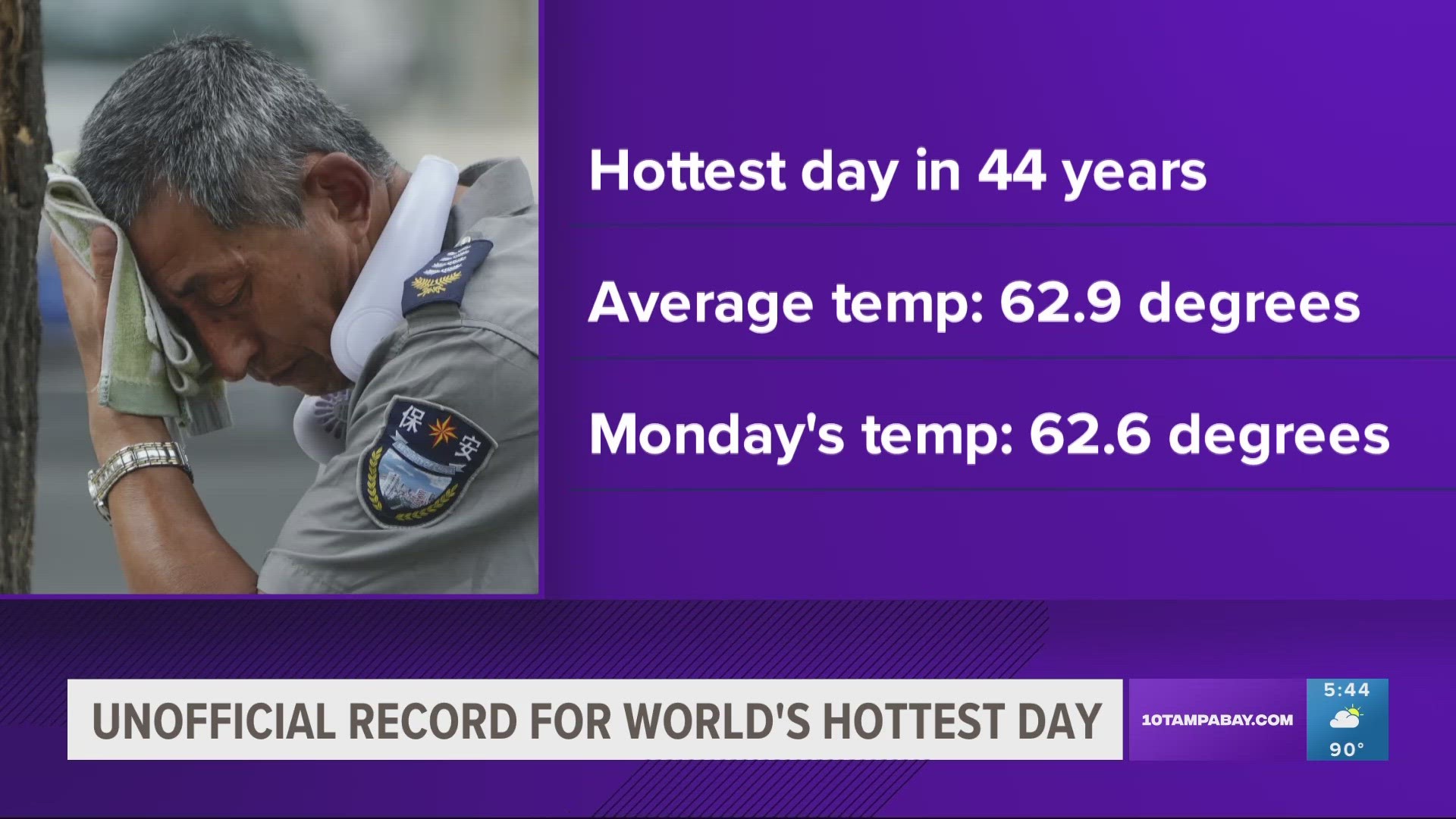WASHINGTON — The entire planet sweltered to the unofficial hottest day in human recordkeeping July 3 and then blasted past that with an even hotter day on July 4, according to University of Maine scientists at the Climate Reanalyzer project.
For two straight days, the global average temperature spiked into uncharted territory. After scientists talked about Monday's dramatic heat, Tuesday soared 0.17 degrees Celsius (0.31 degrees Fahrenheit) even hotter, which is a huge temperature jump in terms of global averages and records.
The same University of Maine climate calculator — based on satellite data and computer simulations — forecasts a similar temperature for Wednesday that would be in record territory, with an Antarctica average that is a whopping 4.5 degrees Celsius (8.1 degrees Fahrenheit) warmer than the 1979-2000 average.
High temperature records were surpassed July 3 and 4 in Quebec and northwestern Canada and Peru. Cities across the U.S. from Medford, Oregon to Tampa, Florida have been hovering at all-time highs, said Zack Taylor, a meteorologist with the National Weather Service. Beijing reported nine straight days last week when the temperature exceeded 35 degrees Celsius (95 degrees Fahrenheit).
“The increasing heating of our planet caused by fossil fuel use is not unexpected, it was predicted already in the 19th century after all,” said climate scientist Stefan Rahmstorf at the Potsdam Institute for Climate Research in Germany. “But it is dangerous for us humans and for the ecosystems we depend on. We need to stop it fast.”
The daily but preliminary and unofficial heat record comes after months of “truly unreal meteorology and climate stats for the year," such as off-the-chart record warmth in the North Atlantic, record low sea ice in Antarctica and a rapidly strengthening El Nino, said University of Oklahoma meteorology professor Jason Furtado.
This global record is not quite the type regularly used by gold-standard climate measurement entities like the National Oceanic and Atmospheric Association. But it is an indication that climate change is reaching into uncharted territory. It legitimately captures global-scale heating and NOAA will take these figures into consideration when it does its official record calculations, said Deke Arndt, director of the National Center for Environmental Information, a division of NOAA.


“In the climate assessment community, I don’t think we’d assign the kind of gravitas to a single day observation as we would a month or a year,’’ Arndt said. Scientists generally use much longer measurements — months, years, decades — to track the Earth's warming. In addition, this preliminary record for the hottest day is based on data that only goes back to 1979, the start of satellite record-keeping, whereas NOAA’s data goes back to 1880.
But Arndt added that we wouldn't be seeing anywhere near record-warm days unless we were in “a warm piece of what will likely be a very warm era" driven by greenhouse gas emissions and the onset of a “robust” El Nino. An El Nino is a temporary natural warming of parts of the central Pacific Ocean that changes weather worldwide and generally makes the planet hotter.
Human-caused climate change is like an upward escalator for global temperatures, and El Nino is like jumping up while standing on that escalator, Arndt said.
On Tuesday, American independence day, Earth average temperature spiked at 17.18 degrees Celsius or 62.9 degrees Fahrenheit, according to the University of Maine’s Climate Reanalyzer, a common tool often used by climate scientists for a good glimpse of the world’s condition. Tuesday's temperature was nearly a full degree Celsius (1.8 degrees Fahrenheit) warmer than the 1979-2000 average, which is itself is warmer than the 20th and 19th century averages.
On July 3, the reanalyzer had the temperature at 17.01 degrees Celsius (62.6 degrees Fahrenheit).
The reanalyzer is based on a NOAA computer simulation intended for forecasts that use satellite data. It is not based on reported observations from the ground. So this unofficial record is effectively using a weather tool that is designed for forecasts, not record-keeping.
The global daily average temperature for July 3 came in at 17.01 degrees Celsius or 62.6 degrees Fahrenheit. This average temperature may not seem that hot, but it’s the first time in the 44 years of this dataset that the temperature surpassed the 17-degree Celsius mark and then it went even higher.
"A record like this is another piece of evidence for the now massively supported proposition that global warming is pushing us into a hotter future,” said Stanford University climate scientist Chris Field, who was not part of the calculations.
Hotter global average temperatures translate into brutal conditions for people all over the world.


In the U.S., heat advisories are in effect this week for more than 30 million people in places including portions of western Oregon, inland far northern California, central New Mexico, Texas, Florida and the coastal Carolinas, according to the National Weather Service Weather Prediction Center. Excessive heat warnings are continuing across southern Arizona and California, they said.
When the heat spikes, humans suffer health effects.
“Those hotter temperatures that happen when we get hotter than normal conditions? People aren’t used to that. Their bodies aren’t used to that,” said Erinanne Saffell, the Arizona state climatologist and an expert in extreme weather and climate events.
Saffell added that the risk is already high for the young and old, who are vulnerable to heat even under normal conditions.
“That’s important to understand who might be at risk, making sure people are hydrated, they’re staying cool, and they’re not exerting themselves outside and taking care of those folks around you who might be at risk as well,” she said.
___
Borenstein reported from Washington and Walling from Chicago

